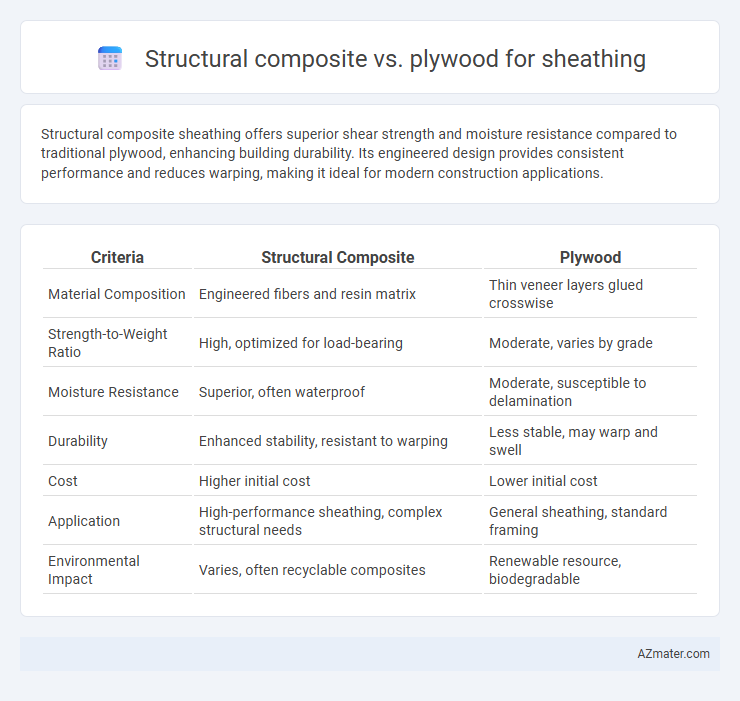Structural composite sheathing offers superior shear strength and moisture resistance compared to traditional plywood, enhancing building durability. Its engineered design provides consistent performance and reduces warping, making it ideal for modern construction applications.
Table of Comparison
| Criteria | Structural Composite | Plywood |
|---|---|---|
| Material Composition | Engineered fibers and resin matrix | Thin veneer layers glued crosswise |
| Strength-to-Weight Ratio | High, optimized for load-bearing | Moderate, varies by grade |
| Moisture Resistance | Superior, often waterproof | Moderate, susceptible to delamination |
| Durability | Enhanced stability, resistant to warping | Less stable, may warp and swell |
| Cost | Higher initial cost | Lower initial cost |
| Application | High-performance sheathing, complex structural needs | General sheathing, standard framing |
| Environmental Impact | Varies, often recyclable composites | Renewable resource, biodegradable |
Introduction to Sheathing Materials
Structural composite panels (SCPs) and plywood are primary sheathing materials used in residential and commercial construction to provide structural support and weather resistance. SCPs, made from engineered wood fibers or strands bonded with adhesives, offer higher strength-to-weight ratios and enhanced uniformity compared to plywood, which consists of thin wood veneers glued together in alternating grain directions. Both materials serve crucial roles in wall, roof, and floor sheathing, impacting the building's overall durability, insulation, and load-bearing capacity.
What is Structural Composite Lumber?
Structural Composite Lumber (SCL) is an engineered wood product made by bonding together wood veneers, strands, or fibers with adhesives to form strong, uniform panels or beams used in construction for sheathing and framing. Unlike plywood, which is composed of cross-laminated thin wood layers, SCL offers higher strength-to-weight ratios, improved dimensional stability, and enhanced resistance to warping and splitting. Common types of SCL include laminated veneer lumber (LVL), parallel strand lumber (PSL), and laminated strand lumber (LSL), each designed to meet specific structural requirements in building sheathing applications.
Plywood: Composition and Features
Plywood sheathing is composed of multiple thin layers of wood veneer glued together with the grain of each layer running perpendicular to the adjacent one, providing enhanced strength and stability. This cross-laminated structure improves resistance to warping, splitting, and swelling compared to traditional wood panels. Plywood's dimensional stability and uniform strength make it a reliable choice for structural sheathing in residential and commercial construction projects.
Strength and Load-Bearing Capabilities
Structural composite panels offer superior strength and load-bearing capabilities compared to traditional plywood, making them ideal for shear walls and roof decking in high-stress environments. Engineered with high-density fibers and adhesives, these composites provide enhanced rigidity and resistance to delamination, resulting in longer-lasting structural integrity under dynamic loads. Plywood, while cost-effective and easy to work with, typically exhibits lower shear strength and is more prone to warping and splitting under heavy loads or moisture exposure.
Moisture Resistance and Durability
Structural composite sheathing offers superior moisture resistance compared to plywood due to its engineered resin-impregnated wood fibers, reducing swelling and warping in wet conditions. Plywood tends to absorb moisture more readily, which can lead to delamination and decreased structural integrity over time. The enhanced durability of structural composite sheathing ensures longer-lasting protection and stability in exterior wall applications where moisture exposure is a concern.
Installation Differences and Ease of Use
Structural composite panels offer a uniform thickness and smooth surface that facilitate quicker installation and easier fastening compared to plywood, which may have inconsistent thickness and surface irregularities. Plywood requires careful alignment of layers due to natural wood grain variations, making it more labor-intensive during installation, while structural composites often come in larger, pre-finished panels enhancing coverage speed. The lighter weight of structural composite sheathing reduces handling effort on-site, improving ease of use and minimizing worker fatigue compared to heavier plywood sheets.
Cost Comparison: Structural Composite vs Plywood
Structural composite panels typically cost 10-20% more than traditional plywood sheathing, reflecting higher manufacturing and material expenses. Plywood remains the more budget-friendly option, with prices averaging $15-$25 per sheet, while structural composites range between $20-$30 per sheet. Despite higher initial costs, structural composites offer enhanced durability and moisture resistance, potentially reducing long-term repair and maintenance expenses.
Environmental Impact and Sustainability
Structural composite panels (SIPs) are often more environmentally friendly than traditional plywood for sheathing due to their efficient use of raw materials and superior thermal performance, which reduces energy consumption in buildings. Plywood production typically involves higher consumption of wood resources and adhesives that may emit volatile organic compounds (VOCs), impacting indoor air quality and ecosystem health. SIPs enhance sustainability through reduced waste generation and improved insulation, lowering a building's carbon footprint over its lifecycle compared to conventional plywood sheathing.
Common Applications in Construction
Structural composite sheathing offers superior strength and moisture resistance, making it ideal for commercial and high-performance residential construction, especially in load-bearing walls and roofs. Plywood is commonly used in traditional framing applications, providing consistent shear strength and ease of installation in flooring, wall, and roof sheathing. Both materials are essential in construction, with structural composites favored for enhanced durability and plywood preferred for cost-effective, versatile applications.
Choosing the Right Sheathing for Your Project
Structural composite panels (SIPs) offer superior insulation and strength compared to plywood, making them ideal for energy-efficient, high-performance building projects. Plywood remains a cost-effective and versatile choice, providing excellent shear strength and moisture resistance for standard framing. Assessing project requirements like load capacity, weather exposure, and budget determines the optimal sheathing material for durability and structural integrity.

Infographic: Structural composite vs Plywood for Sheathing
 azmater.com
azmater.com